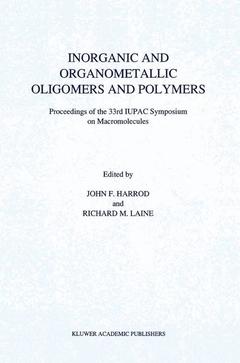Inorganic and Organometallic Oligomers and Polymers, 1991 Proceedings of the 33rd IUPAC Symposium on Macromolecules
Langue : Anglais
Coordonnateurs : Harrod J.F., Laine R.M.

Although, carbon is only one of one hundred plus elements, the polymer science lit erature consists primarily of studies on carbon based polymers. In part, this reflects the varied feedstock sources and in part, the type of bonds and bond forming reactions avail able to form organic polymers that are not available to the inorganic and organometallic chemist. However, recent intense interest in polymers with novel optical, electronic or magnetic properties or polymers that can serve as precursors to ceramic, semiconductor, metallic or superconductor materials has served as a driver for the development of novel synthetic routes and characterization techniques that have launched many new inorganic and organometallic oligomers and polymer systems. The following chapters represent an effort to provide an overview of several new and continuing areas of development in inorganic and organometallic polymer science. This book represents the second in a series of books we have edited on inorganic and organometallic polymer chemistry (1. Transformation of Organo-metallics into Common and Exotic Materials, NATO ASI Series Vol 141. 3. Inorganic and Organometallic Polymers with Special Properties, NATO ASI Series in press). In this series, we attempt to develop, for the reader, an understanding of the breadth, depth and potential of inorganic and organometallic polymer science.
Polysilanes and Polystannanes.- Catalytic Dehydrogenative Polymerization of Silanes to Polysilanes by Zirconocene and Hafnocene Catalysts. A New Polymerization Mechanism..- Silane Dehydrocoupling Reactions Catalyzed by the Late Transition Metals.- Synthesis of Poly(methylsilylene) by Catalytic Dehydrocoupling with Cp2MMe2 (M=Ti, Zr) Catalysts..- The Preparation of Polysilylenes.- Characterization of Polysilanes by UV, GPC and Light-Scattering.- Effect of Thermally Induced Transitions on Electronic Transport in Aliphatic Polysilylenes.- Linear and Nonlinear Optics in Substituted Polysilanes.- Electronic Structures and Physical Properties of Sigma-Conjugated Polymers.- The Molecular and Electronic Structure of Polycyclic Polystannanes.- Non-oxide Ceramic Precursors.- Polymethylsilane as a Precursor to High Purity Silicon Carbide.- Silicon Carbide Preceramic Polymers as Binders for Ceramic Powders.- Pyrolytic Characteristics of Polysilazanes.- Silicon and Boron Containing Oligomers: Potential Precursors for Ceramics.- Preparation and Microstructure of Organometallic Polymer Derived AIN-BN Composites.- Polymeric Precursors to Boron Nitride Ceramics.- Ceramic Materials via Derivatization Reactions of Polymers.- Oxide Ceramic Precursors.- Some Aspects of the Chemistry of Transition Metal Oxide Gels.- Kinetics and Structure of Silicate Sol-Gels.- Mechanistic Aspects of the Pyrolytic Transformation of Metal Alkoxides to Oxides.- Novel Organometallic Polymers.- Poly(alkylene phosphates): Synthetic Strategies.- New Metal-Chalcogen Compounds with Polymeric Structures.- The Study of Plasma Stability of Poly (Organophosphazene) Films Prepared on Silicon Wafer.- Oxygen-Carrying Polychelates Derived from Bisphenolic Complexes.- Coordination Polymers Derived from Bisphenolic Complexes.- List of Key Words, Names.
Date de parution : 10-2012
Ouvrage de 316 p.
15.5x23.5 cm
Thèmes d’Inorganic and Organometallic Oligomers and Polymers :
Mots-clés :
Compound; Coupling reaction; Gel-Permeations-Chromatographie; Polycarbonat; Polymer; Polysilazane; ceramics
© 2024 LAVOISIER S.A.S.



